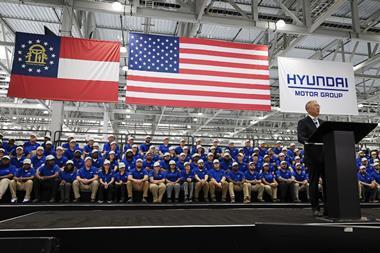
Speaking at the conference, Cai Jin, vice-president of the China Federation of Logistics and Purchasing, said that high costs, including those for logistics, have become the number one challenge for the automotive industry this year. After logistics cost as a percentage of GDP rose to a record level of 17.8% in 2011, Cai said that such costs rose above 18% in 2012.
Carmakers and tier suppliers confirmed the high costs for logistics in the automotive sector. Dr Jörg Biesemann, director of logistics for automotive in Asia pacific at the tier one Continental, said that logistics as a percentage of product costs often exceeded 20% in China. Comparable costs for automotive in Europe or North America are closer to 6-7%, he said.
Partly as a response to these costs, the Chinese government, now under new leadership, has put a new focus on increasing multimodal transport, including ongoing plans to liberalise its railways. Zhang Xiaodong, professor of the Transport College at Beijing JiaoTong University, revealed that the Chinese government has changed the structure of its state-owned railways, replacing the Ministry of Railways with several new departments. In an effort to increase safety, for example, planning and standards will now be set by a National Railways Bureau. Meanwhile, in a move towards opening up the market to more competition, the China Railway Corporation will be responsible for operations. “This is the foundation for a further marketisation of the railways, and many policy decisions are currently still being decided,” he said.
Logistics providers, both domestic and foreign, are being actively encouraged to participate in the plans. Ideas from industry experts need to be integrated, said Dr Liu Xilong from China's National Development and Reform Commission, a powerful government policy department. “I hope the industry can work closely with the government to better service the growth of the industry,” he said. “There is a bright future ahead if we can address quality and efficiency.”
According to the CFLP’s Cai and other speakers, the other major challenge for automotive logistics is overcapacity. Although production capacity utilisation is above 100% in some cases, Chinese carmakers are producing at around 60% of capacity, said Biesemann. “I’m getting a bit nervous as I know the Chinese OEMs are planning to setup another ten assembly plants,” he said.
Rather than continuing to grow at breakneck speed, the industry needs to refocus its growth towards one that is more sustainable and profitable, said Cai. “We need to address costs and capacity,” he said. “To solve them we need to look at the economic transition model, and concentrate on efficiency and quality for better profitability.”
That transition model will be important for identifying the priorities for the future of the automotive logistics industry, according to the NDRC’s Liu. He pointed towards a rebalancing of the Chinese economy from mass manufacturing towards light industry and service.
“The service sector is going to be a major driver for the economy,” said Liu.
“Our production model is a factor,” added Cai. “Because in the past our economy was in shortage, we focused on mass production. Now we need to look at a new method of production. And then we need to change the management of logistics. This will bring savings.”
Although Chinese economic growth is moderating, the logistics sector continues to expand at a fast pace According to Cai, while China’s GDP grew 7.7% in the first quarter of 2013, the logistics industry expanded by 9.5%. Automotive production has also grown by 13.5% compared to last year.
A full report on the Automotive Logistics China conference will be online here next week.

























![Global[1]](https://d3n5uof8vony13.cloudfront.net/Pictures/web/a/d/s/global1_726550.svgz)










